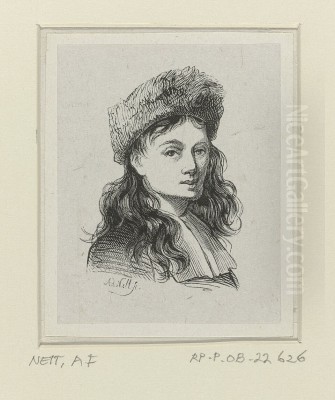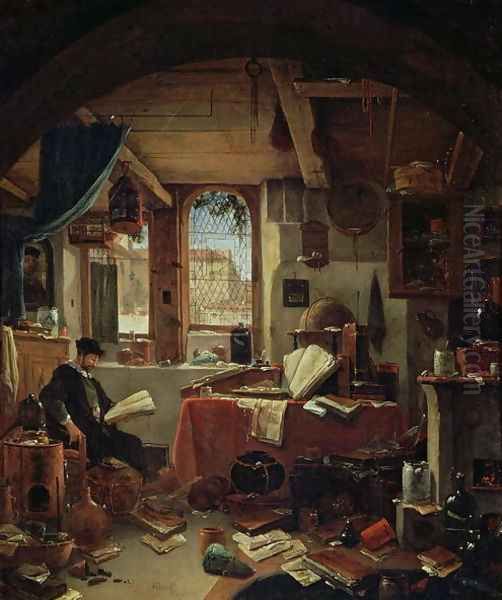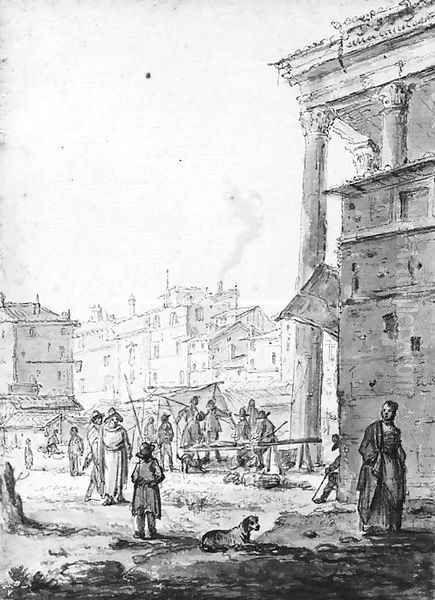
Thomas Wyck stands as a notable figure among the Dutch Golden Age painters, an artist whose life and work bridged the meticulous realism of his homeland with the sun-drenched allure of Italy. Born likely around 1616, possibly in Beverwijk near the bustling artistic center of Haarlem, and passing away in Haarlem in August 1677, Wyck carved a niche for himself with his evocative depictions of Mediterranean harbours, Italianate landscapes, bustling marketplaces, and intriguing scenes of alchemists in their laboratories. His career reflects the era's fascination with foreign lands, particularly Italy, and the desire to capture both the exotic and the everyday aspects of life beyond the Netherlands.
Early Life and Artistic Formation
While concrete details about Thomas Wyck's earliest years and training remain somewhat scarce, his emergence as an artist coincides with the flourishing of the Dutch Golden Age. Haarlem, where he spent significant parts of his life, was a crucible of artistic innovation. Painters like Frans Hals were revolutionizing portraiture, while landscape artists such as Jacob van Ruisdael and genre painters like Adriaen van Ostade and his brother Isack van Ostade were defining new ways of seeing the world. It is within this vibrant context that Wyck likely received his initial training, absorbing the Dutch emphasis on careful observation, detailed rendering, and the depiction of daily life.
His father, also named Thomas Wyck, was recorded as a painter and art dealer, suggesting an early immersion in the art world. This familial connection may have provided initial guidance and access to the artistic community. By 1642, Thomas Wyck the younger was accomplished enough to be admitted as a master into the prestigious Haarlem Guild of Saint Luke, a necessary step for any artist wishing to practice professionally, take on pupils, or sell their work independently within the city. Membership in the Guild placed him alongside esteemed contemporaries like Philips Wouwerman, known for his cavalry scenes, and Nicolaes Berchem, another prominent Italianate painter.
The Transformative Italian Journey

A pivotal period in Wyck's artistic development was his journey to Italy. While the exact dates are debated by scholars, it is generally accepted that he travelled south sometime in the latter half of the 1640s. This voyage was part of a well-established tradition for Northern European artists, who sought inspiration from the classical ruins, Renaissance masterpieces, and the unique light and atmosphere of Italy. Unlike some contemporaries who focused primarily on the grandeur of ancient Rome or idealized pastoral landscapes, Wyck seemed particularly drawn to the vibrant, lived-in spaces of Italian cities and ports.
His time in Italy profoundly shaped his subject matter. He became known for his depictions of Mediterranean coastal scenes, lively town squares, intimate courtyards, and harbours filled with merchants, sailors, and travellers. These works often feature a warm palette, capturing the effect of southern light, and are populated with numerous small figures engaged in various activities, lending a sense of energy and narrative to the scenes. This focus on everyday life in Italian settings aligns him broadly with the group of Dutch and Flemish painters active in Rome known as the Bamboccianti, followers of Pieter van Laer (nicknamed 'Il Bamboccio'), although Wyck developed his own distinct style. Other Dutch artists exploring Italian themes around this time included Jan Both and Jan Asselijn.
The experience earned him recognition, possibly even during his time abroad, as suggested by the later description of him as "il disegnante Italianico" (the Italianate draughtsman). This title highlights not only his subject matter but also his skill in capturing the essence of Italian scenes, likely through numerous sketches made on location which later served as basis for paintings completed back in his studio in Haarlem.
Artistic Style and Thematic Focus
Thomas Wyck's artistic style is characterized by a blend of Dutch precision and Italian atmosphere. He excelled in rendering architectural details, capturing the textures of stone, plaster, and tile with convincing realism. His compositions often employ strong diagonal lines and contrasts between brightly lit areas and deep shadows, creating a sense of depth and drama reminiscent, albeit in a different context, of the chiaroscuro techniques famously used by artists like Caravaggio and Rembrandt, though Wyck's application was typically less intense and more focused on defining space and form within complex urban environments.

His paintings frequently depict the hustle and bustle of Mediterranean port cities, showing ships at anchor, goods being loaded and unloaded, and diverse figures interacting near quays and warehouses. Market scenes were another favourite theme, allowing him to showcase a variety of social types and activities within a detailed architectural setting. He paid close attention to the staffage – the small human and animal figures – ensuring they were lively and contributed to the overall narrative and atmosphere of the scene.
Interestingly, Wyck also developed a reputation for painting interiors, particularly scenes of scholars and, most notably, alchemists in their laboratories. These works are filled with the paraphernalia of alchemy – furnaces, alembics, mortars, pestles, books, and globes – rendered with the same meticulous detail found in his outdoor scenes. These interiors often feature dramatic lighting, with a single source illuminating the central figures and casting deep shadows, enhancing the sense of mystery and intellectual pursuit associated with the alchemist's craft.
A key aspect noted by art historians is Wyck's preference for depicting the authentic, sometimes gritty, reality of Italian streets and courtyards, rather than focusing solely on idealized classical ruins or romanticized landscapes, a path taken by artists like Claude Lorrain or Salvator Rosa. Wyck captured the everyday fabric of the cities, the worn facades of buildings, and the unglamorous corners, giving his Italian views a unique sense of immediacy and realism.
Representative Works: The Palazzo Contarini del Bovolo
While many of Wyck's works depict generic Mediterranean ports or Italian townscapes, one specific location he captured stands out: the Palazzo Contarini del Bovolo in Venice. His painting, View of the Palazzo Contarini del Bovolo, Venice, showcases his skill in architectural representation and his interest in unique urban features. The Palazzo is famous for its distinctive external spiral staircase (the 'bovolo' or snail shell), added around 1499 by the architect Giovanni Candi during a renovation.
Wyck’s depiction likely stems from sketches made during his Italian travels. The painting captures the intricate structure of the staircase winding up the building's facade, set within the context of the surrounding Venetian architecture. It demonstrates his ability to handle complex perspective and to integrate architectural elements into a cohesive and visually engaging composition. This work serves as a prime example of his exploration of 17th-century Italian architecture, providing valuable visual documentation of the building during that period and showcasing his eye for compelling architectural subjects beyond the more commonly depicted landmarks. While this specific view is highlighted, it represents his broader interest in capturing the unique character of Italian urban environments.
Later Career: Haarlem and England
After his formative experiences in Italy, Thomas Wyck returned to Haarlem, where he continued his successful career. He remained an active member of the artistic community, and his Italianate works found a ready market among Dutch collectors fascinated by the South. His studio likely produced numerous variations on his popular themes – harbours, markets, courtyards, and alchemist labs.
Around the time of the English Restoration (1660), Wyck travelled to England, possibly accompanying his son, Jan Wyck. Thomas spent several years in London, adapting his skills to a new environment. During this period, he is believed to have painted views of London and its surroundings, including depictions of the River Thames and possibly scenes related to the Great Fire of London in 1666, although definitive works documenting the fire are more commonly associated with other artists. His time in England exposed him to a different artistic milieu, potentially interacting with or observing the work of prominent figures active there, such as the court portraitist Sir Peter Lely or the miniaturist Samuel Cooper.
His son, Jan Wyck (c. 1645–1702), followed in his father's footsteps but specialized primarily in battle scenes, equestrian portraits, and hunting scenes, becoming a significant painter in England in his own right. Jan's success suggests the Wyck family established a lasting artistic presence in their adopted country. Thomas Wyck eventually returned to Haarlem, where he died and was buried in the Grote Kerk (St. Bavo's Church) on August 19, 1677.
Contemporaries and Artistic Circle
Throughout his career, Thomas Wyck operated within a rich network of artists, both in the Netherlands and potentially during his travels. In Haarlem, he was contemporary with masters of landscape, genre, and still life. Besides those already mentioned (van Ruisdael, the Ostade brothers, Wouwerman, Berchem), the city hosted talents across various specializations. While the provided snippets indicate no specific documented records of direct collaboration or close personal friendships with many of these figures, the shared environment of the Guild and the city's art market implies awareness and likely professional interaction.
His engagement with the Italianate style placed him in dialogue with other Dutch artists who travelled south or adopted southern themes, such as Karel Dujardin, Adam Pynacker, and the aforementioned Bamboccianti. Wyck's interpretation, however, maintained a distinct character, often more detailed and less idealized than some of his contemporaries. His later period in England brought him into proximity with the Restoration art scene, dominated by portraiture but also featuring landscape and marine painters. While his direct interactions remain unclear, his presence contributed to the exchange of artistic ideas between the Continent and Britain. The subsequent career of his son Jan, who worked alongside artists like Godfrey Kneller, further cemented the Wyck family's connection to the English art world.
Art Historical Significance and Legacy
Thomas Wyck holds a respected place in Dutch art history, primarily as a skilled practitioner of the Italianate genre. His work is valued for its detailed observation, atmospheric quality, and its contribution to the Northern European fascination with Italy. He successfully merged the Dutch tradition of realism and genre painting with the exotic appeal of Mediterranean settings. His depictions of Italian ports, streets, and courtyards offer valuable insights into the appearance and daily life of these locations in the 17th century, capturing aspects often overlooked by artists focused on grander vistas or classical antiquity.
His status as "il disegnante Italianico" underscores his proficiency in capturing the specific character of Italy, suggesting a reputation based on his drawings and paintings derived from his travels. His works, particularly the alchemist scenes, also tap into contemporary interests in science, scholarship, and the esoteric. Though perhaps not as revolutionary as some of his Dutch contemporaries like Rembrandt or Vermeer, Wyck was a consistently competent and often highly engaging painter whose works were popular during his lifetime and continue to be appreciated today.
Modern scholarship, as indicated by studies like the 2014 article focusing on his View of the Palazzo Contarini del Bovolo, continues to explore his contributions, particularly his role in documenting architecture and his place within the broader context of Dutch Italianate painting. His legacy is also carried on through the work of his son, Jan Wyck, who became a prominent painter in England.
Conclusion
Thomas Wyck navigated the vibrant art world of the Dutch Golden Age with skill and adaptability. From his roots in Haarlem, his transformative journey to Italy shaped a significant portion of his oeuvre, leading to evocative depictions of Mediterranean life that combined Dutch detail with southern light. His diverse subjects, ranging from bustling harbours and markets to contemplative alchemist laboratories and specific architectural studies like the Palazzo Contarini del Bovolo, demonstrate his versatility. His later work in England further broadened his horizons. As a key figure among the Dutch Italianate painters and a meticulous observer of both everyday life and architectural form, Thomas Wyck left behind a body of work that continues to offer visual delight and historical insight into the interconnected world of 17th-century Europe.